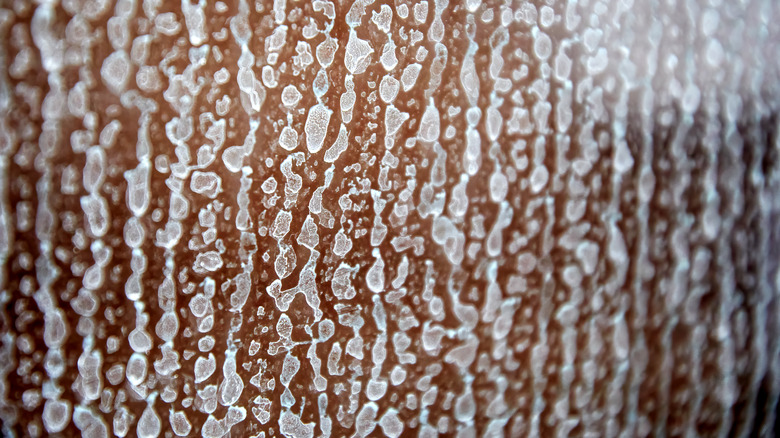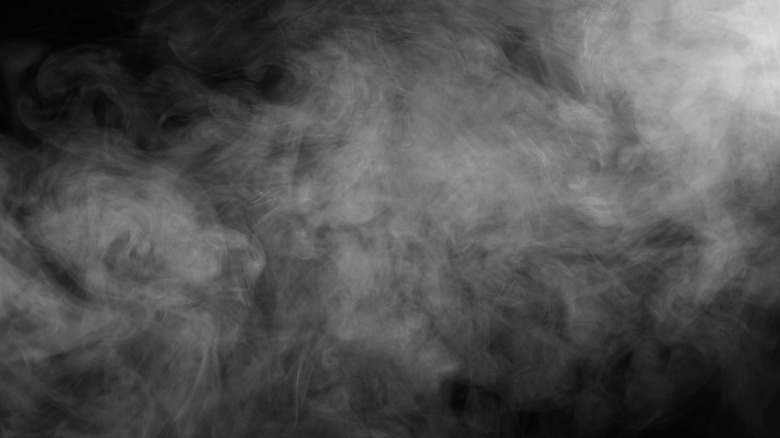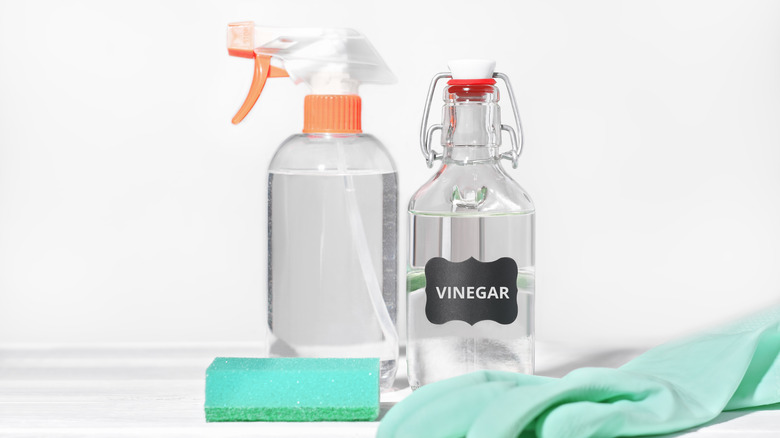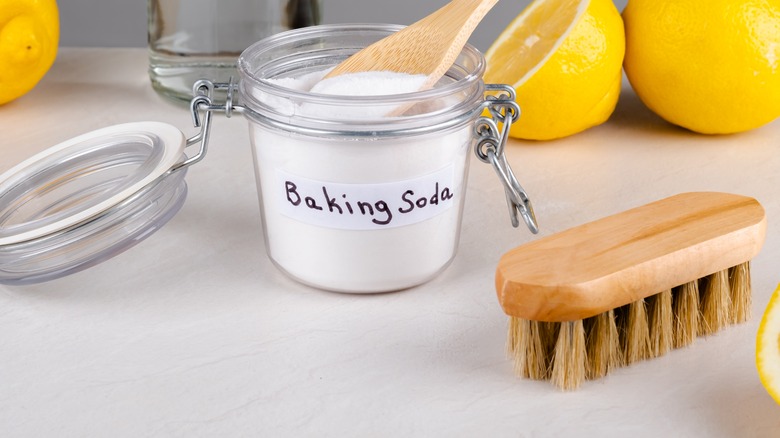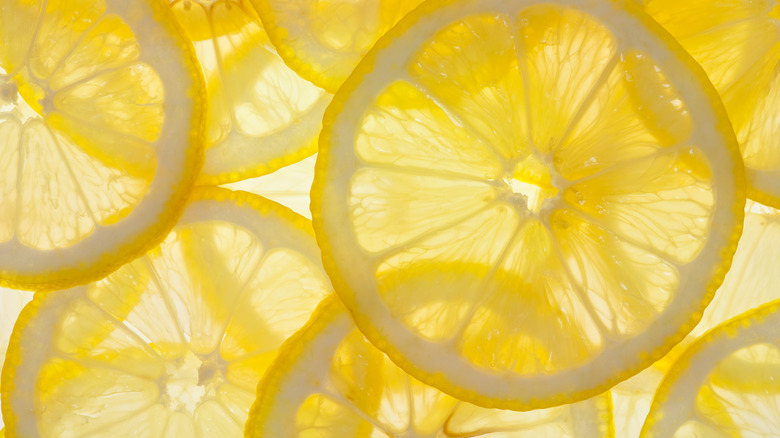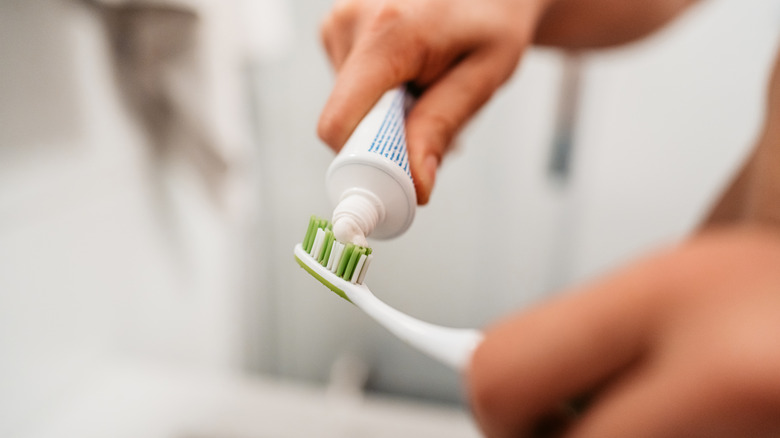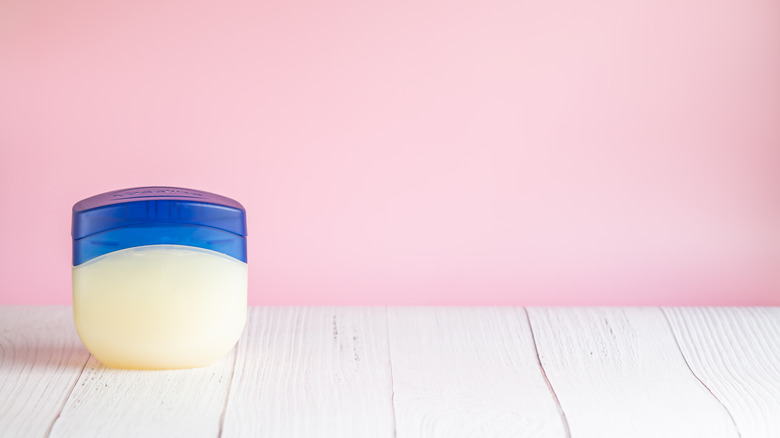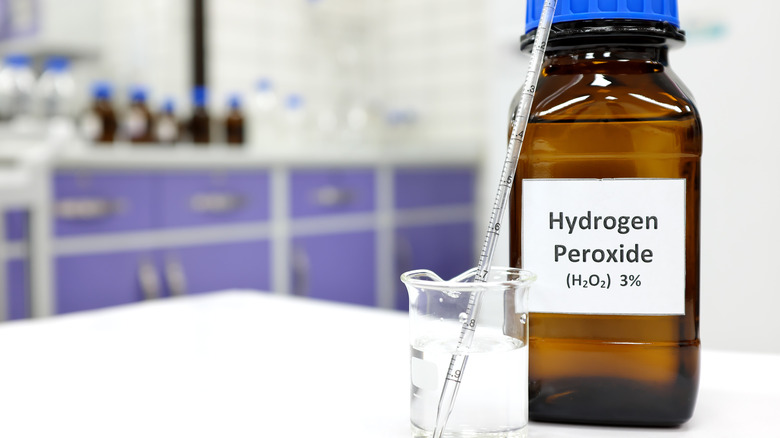Easily Remove Limescale With These Game-Changing Ingredients
We've all seen limescale build up on faucets, fixtures, glass shower doors, or even on tea kettles around the home. We know that the chalky white film can be a pain to remove, but what exactly is it, and how does it form? Limescale most commonly forms in homes with hard water — that is, water with a high mineral content — when it evaporates or is heated. Calcium ions in water can become insoluble calcium carbonate when heated, while magnesium ions can interact with soaps to produce insoluble magnesium stearate. Both calcium carbonate and magnesium stearate can contribute to a build-up of salts and soap scum that can be difficult to remove, otherwise known as limescale.
Limescale is not only visually unappealing, but it can also pose a risk to your home's plumbing and heating systems over time. According to Goodway HVAC, limescale buildup in pipes can reduce the overall energy efficiency of your home, and can eventually make pipes more prone to leaks and breaks. These are just two of the horrors that limescale can cause; others include clogged pipes, odors, and visible corrosion on bathroom fixtures. If you notice an unusual amount of limescale on bathroom faucets and showers, it might be time to consider a more permanent solution, such as a water softener — but in the meantime, you can send limescale stains packing with a few key ingredients. Remove those pesky stains with mild acids and other ingredients that dissolve or prevent buildup, including some household staples you might not expect.
Steam
A good first step in tackling limescale is a simple one: add steam! If you have a steam cleaner, it can help remove lighter limescale accumulations in combination with a little scrubbing. The high heat of steam can sanitize surfaces while breaking up scum and scale, all without the need for chemical descalers. Steam cleaning can also help with cleaning tile, glass, and grout in the bathroom, among other applications. Just be sure to avoid surfaces that don't do well with steam cleaning.
If you don't have a steam cleaner, you can try boiling water in a kettle or adding steam with an iron to loosen up limescale before scrubbing your fixtures, but these methods may be less effective. It might also make sense to use steam in combination with other methods, such as those listed below, for heavier limescale deposits.
White vinegar
You may already know that white vinegar can be a versatile cleaning tool around the home, with antibacterial properties and the ability to dissolve buildup. For limescale, the Guardian recommends wrapping cotton pads soaked in vinegar around taps and letting them sit for an hour, or to fill a cup with vinegar and secure it to a tap to soak. You can also clean your shower head with vinegar using a one-to-one solution of hot water and vinegar and letting it soak in a bucket (if detachable) or plastic bag of the solution (if not detachable).
The acetic acid in vinegar will work to break up calcium carbonate and other deposits over time. Most sources recommend leaving vinegar to soak on your appliances before wiping or scrubbing clean so that the acid has enough time to take effect chemically on the limescale. This can prevent scratching your appliances with harsh scrubbing and will add a limescale-free shine to your fixtures to boot.
Baking soda
For a gentler method of soaking appliances and removing limescale, Ask Team Clean suggests a mixture of water and baking soda. They also recommend making a paste with two or three teaspoons of baking soda and water as needed to apply directly to stubborn limescale spots. Of the many baking soda cleaning hacks, these methods could freshen up your appliances and remove scale without the strong smell of vinegar.
From school science projects to conventional home cleaning advice, you may have heard that baking soda's power can be enhanced by combining it with vinegar. But before you combine the two, you should know that this combination, while fizzy, cancels out the cleaning power of both the acids in vinegar and the abrasives in baking soda, so it may not be useful in removing limescale. It's better to create a more concentrated solution of either vinegar or baking soda to test out on tougher limescale buildup.
Lemon juice
Looking for a mild household acid to use on limescale that also adds a fresh, clean scent to your bathroom or kitchen? Look no further than lemon juice and its many household applications — just like other citrus fruits, there are more household uses for lemons than you might think. Remove limescale from faucets with a hack where you simply rub half a lemon into the tap head, or juice a lemon and apply the juice to fixtures with a cleaning cloth to reach scale in other areas. As with white vinegar, you should let the lemon juice sit on fixtures for a while for the acids to take effect. In this case, the citric acid, rather than acetic acid, in lemons and other citrus fruits is what makes this scale-dissolver work.
Fluoride
That's right, the same ingredient that protects your teeth can protect your glass surfaces from limescale! You can use toothpaste to remove hard water stains from glass shower doors, and even to shine mirrors. The fluoride in traditional toothpastes interacts with the calcium and magnesium in limescale and breaks up scale just like it breaks up plaque on your teeth. It's also mild enough that it can bust grime without damaging or scratching your glass.
It's important to note that although they may contain fluoride, gel toothpastes are not the right fit for this trick. For limescale removal, apply a traditional white toothpaste in a thin layer on limescale-afflicted glass, let sit for a few minutes, then gently scrub with a sponge. Rinse the area with water thoroughly, and enjoy both the minty scent and the clear shine of your glass surfaces!
Petroleum jelly
If you've had success eliminating hard water stains with any of the above methods, you might be wondering how to keep limescale from returning in the future. Without buying a water softener to eliminate hard water stains at the source, it may seem inevitable that limescale will eventually return. But a common home toiletry can come to the rescue around the house, too: we're talking about Vaseline. Vaseline, or petroleum jelly, can help remove and prevent hard water stains, especially in wood. This is because the petroleum repels water, and therefore prevents water-based buildup around the home.
For water stains on wooden surfaces, simply apply a thin layer of Vaseline to your surface and let sit — as long as overnight — before wiping excess petroleum clean. You'll see shinier wooden surfaces in addition to limescale removal with this trick!
Hydrogen peroxide
For our final limescale-fighting ingredient, we turn to the medicine cabinet. You likely already have hydrogen peroxide in the house for wound care or other first-aid purposes, making it an easy fix for limescale buildup in the bathroom. Remove limescale with hydrogen peroxide by adding it directly to a spray bottle and applying it to your faucets and fixtures. Let it sit for up to half an hour, then wipe the area clean with a damp cloth.
Hydrogen peroxide, like vinegar and lemon juice, contains a weak acid that is perfect for breaking up limescale. We recommend the household-grade 3% solution of hydrogen peroxide for limescale removal rather than the stronger concentrations; applied regularly, this mild solution should easily do the trick.
